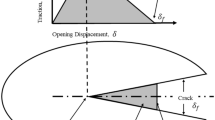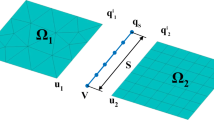Abstract
A cohesive zone model (CZM) approach is applied to simulate mixed-mode I/III stable tearing crack growth events in specimens made of 6061-T6 aluminum alloy and GM 6208 steel. The materials are treated as elastic–plastic following the \(J_{2}\) flow theory of plasticity, and the triangular cohesive law is employed to describe the traction-separation relation in the cohesive zone ahead of crack front. A hybrid numerical/experimental approach is employed in simulations using 3D finite element method. For each material, CZM parameter values are chosen by matching simulation prediction with experimental measurement (Yan et al. in Int J Fract 144:297–321, 2009), of the crack extension-time curve for the \(30^{\circ }\) mixed-mode I/III stable tearing crack growth test. With the same sets of CZM parameter values, simulations are performed for the \(60^{\circ }\) loading cases. Good agreements are reached between simulation predictions of the crack extension-time curve and experimental results. The variations of CTOD with crack extension are calculated from CZM simulations under both \(30^{\circ }\) and \(60^{\circ }\) mixed-mode I/III conditions for the aluminum alloy and steel respectively. The predictions agree well with experimental measurements (Yan et al. in Int J Fract 144:297–321, 2009). The findings of the current study demonstrate the applicability of the CZM approach in mixed-mode I/III stable tearing simulations and reaffirm the connection between CTOD and CZM based simulation approaches shown previously for mixed-mode I/II crack growth events.
















Similar content being viewed by others
References
Abaqus 6.11 Analysis User’s Manual
Alfaiate J, Wells GN, Sluys LJ (2002) On the use of embedded discontinuity elements with crack path continuity for mode-I and mixed-mode fracture. Eng Fract Mech 69(2002):661–686
Alfano M, Lubineau G, Furgiuele F, Paulino GH (2011) On the enhancement of bond toughness for Al/epoxy T-peel joints with laser treated substrates. Int J Fract 171(2):139–50
Amstutz BE, Sutton MA, Dawicke DS, Newman JC Jr (1995) An experimental study of CTOD for mode I/modeII stable crack growth in thin 2024-T3 aluminum specimens. Fracture Mechanics, ASTM, STP 1256, pp 256–271
Anvari M, Scheider I, Thaulow C (2006) Simulation of dynamic ductile crack growth using strain-rate and triaxiality-dependent cohesive elements. Eng Fract Mech 73:2210–2228
Barenblatt GI (1959) The formation of equilibrium cracks during brittle fracture. General ideas and hypothesis. Axially-symmetric cracks. Prikl Matem I Mekham 23:434–444
Barenblatt GI (1962) Mathematical theory of equilibrium cracks. Adv Appl Mech, vol 7. Academic Press, New York, pp 55–125
Barpi F, Valente S (1998) Size-effects induced bifurcation phenomena during multiple cohesive crack propagation. Int J Solids Struct 35(16):1851–1861
Boone ML (1997) Ductile crack growth in an aluminum aircraft fuselage material, Honors College Undergraduate Thesis, University of South Carolina, Columbia, SC, USA
Camanho PP, Dávila CG, de Moura MF (2003) Numerical simulation of mixed-mode progressive delamination in composite materials. J Compos Mater 37:1415–1438
Chen X, Deng X, Sutton MA (2013) Simulation of Stable Tearing Crack Growth Events Using the Cohesive Zone Model Approach. Eng Fract Mech 99(2):223–238
Chen X, Deng X, Sutton MA, Zavattieri PD (2014) An inverse analysis of cohesive zone model parameter values for ductile crack growth simulations. Int J Mech Sci 79:206–215
Cirak F, Ortiz M, Pandolfi A (2005) A cohesive approach to thin-shell fracture and fragmentation. Comput Methods Appl Mech Eng 194:2604–2618
Deng X, Newman JC Jr (1999) A study of some issues in stable tearing crack growth simulations. Eng Fract Mech 64:291–304
Dugdale DS (1960) Yielding of steel sheets containing slits. J Mech Phys Solids 8:100–108
Gullerud AS, Dodds RH, Hampton RW (1999) Dawicke DS. 3-D modeling of ductile crack growth in thin sheet metals: computational aspects and validation. Eng Fract Mech 63:347–374
Kamat SV, Hirth JP (1995) Mixed mode fracture toughness of engineering materials. J Eng Mater Technol 117:391–394
Knauss WG (1970) An observation of crack propagation in anti-plane shear. Int J Fract Mech 6(2):183–7
Lan W, Deng X, Sutton MA (2007) Three-dimensional finite element simulations of mixed-mode stable tearing crack growth experiments. Eng Fract Mech 74:2498–2517
Li W, Siegmund T (2002) An analysis of crack growth in thin-sheet metal via a cohesive zone model. Eng Fract Mech 69(18):2073–2093
Liu S, Chao YJ, Zhu X (2004) Tensile-shear transition in mixed mode I/III fracture. Int J Solids Struct 41(2004):6147–6172
Marat-Mendes RM, Freitas MM (2010) Failure criteria for mixed mode delamination in glass fibre epoxy composites. Compos Struct 92(2010):2292–2298
Newman JC Jr (1984) An elastic–plastic finite element analysis of crack initiation, stable crack growth, and instability. In: Fracture Mechanics. Philadelphia: American Society for Testing and Materials. ASTM STP, 833, pp 93–117
Rashid F, Banerjee A (2013) Implementation and validation of triaxiality dependent cohesive model: experiments and simulations. Int J Fract 181:227–239
Siegmund T, Brocks W (2000) A numerical study on the correlation between the work of separation and the dissipation rate in ductile fracture. Eng Fract Mech 67:139–154
Sommer E (1969) Formation of fracture ‘lances’ in glass. Eng Fract Mech 1:539–546
Sun C, Thouless MD, Waas AM, Schroeder JA, Zavattieri PD (2008) Ductile-brittle transition in the fracture of plastically-deforming adhesively-bonded structures. Part II: numerical studies. Int J Solids Struct 45(17):4725–4738
Suresh S, Shih CF, Morrone A, O’Dowd NP (1990) Mixed-mode fracture toughness of ceramic materials. J Am Ceram Soc 73(5):1257–67
Sutton MA, Deng X, Ma F, Newman JC Jr, James M (2000) Development and application of a crack tip opening displacement-based mixed mode fracture criterion. Int J Solids Struct 37:3591–3618
Sutton MA, Yan J Deng X, Cheng CS, Zavattieri P, (2007) Three-dimentional digital image correlation to quantify deformation and crack-opening displacement in ductile aluminum under mixed-mode I/III loading. Opt Eng 46(5):051003-1–051003-17
Tvergaard V (2008) Effect of T-stress on crack growth under mixed mode I–III loading. Int J Solids Struct 45(2008):5181–5188
Tvergaard V (2010) Effect of pure mode I, II or III loading or mode mixity on crack growth in a homogeneous solid. Int J Solids Struct 47(2010):1611–1617
Wei Z (2008) Study of fracture in ductile thin sheets under remote I/III loading. Doctoral Thesis, University of South Carolina, Columbia, SC, USA
Wei Z, Deng X, Sutton MA, Yan J, Cheng CS, Zavattieri P (2011) Modeling of mixed-mode crack growth in ductile thin sheets under combined in-plane and out-of-plane loading. Eng Fract Mech 78(2011):3082–3101
Wells AA (1961) Unstable crack propagation in metals: cleavage and fast fracture. Proc Cranfield Crack Propag Symp 1:210–230
Wells AA (1963) Application of fracture mechanics at and beyond general yielding. Br Weld J 11:563–570
Xu Y, Yuan H (2011) Applications of normal stress dominated cohesive zone models for mixed-mode crack simulation based on extended finite element methods. Eng Fract Mech 78:544–558
Yan J, Sutton MA, Deng X, Wei Z, Zavattieri P (2009) Mixed-mode crack growth in ductile thin-sheet materials under combined in-plane and out-of-plane loading. Int J Fract 144:297–321
Zavattieri PD (2006) Modeling of crack propagation in thin-walled structures using a cohesive model for shell elements. J Appl Mech 73:948–958
Acknowledgments
The authors gratefully acknowledge the financial support provided by AFOSR (Grant # FA9550-09-0543; program manager Dr. David S. Stargel) and by a SPARC Fellowship to Xin Chen from the University of South Carolina.
Author information
Authors and Affiliations
Corresponding author
Rights and permissions
About this article
Cite this article
Chen, X., Deng, X., Sutton, M.A. et al. Simulation of mixed-mode I/III stable tearing crack growth events using the cohesive zone model approach. Int J Fract 189, 59–75 (2014). https://doi.org/10.1007/s10704-014-9962-4
Received:
Accepted:
Published:
Issue Date:
DOI: https://doi.org/10.1007/s10704-014-9962-4




